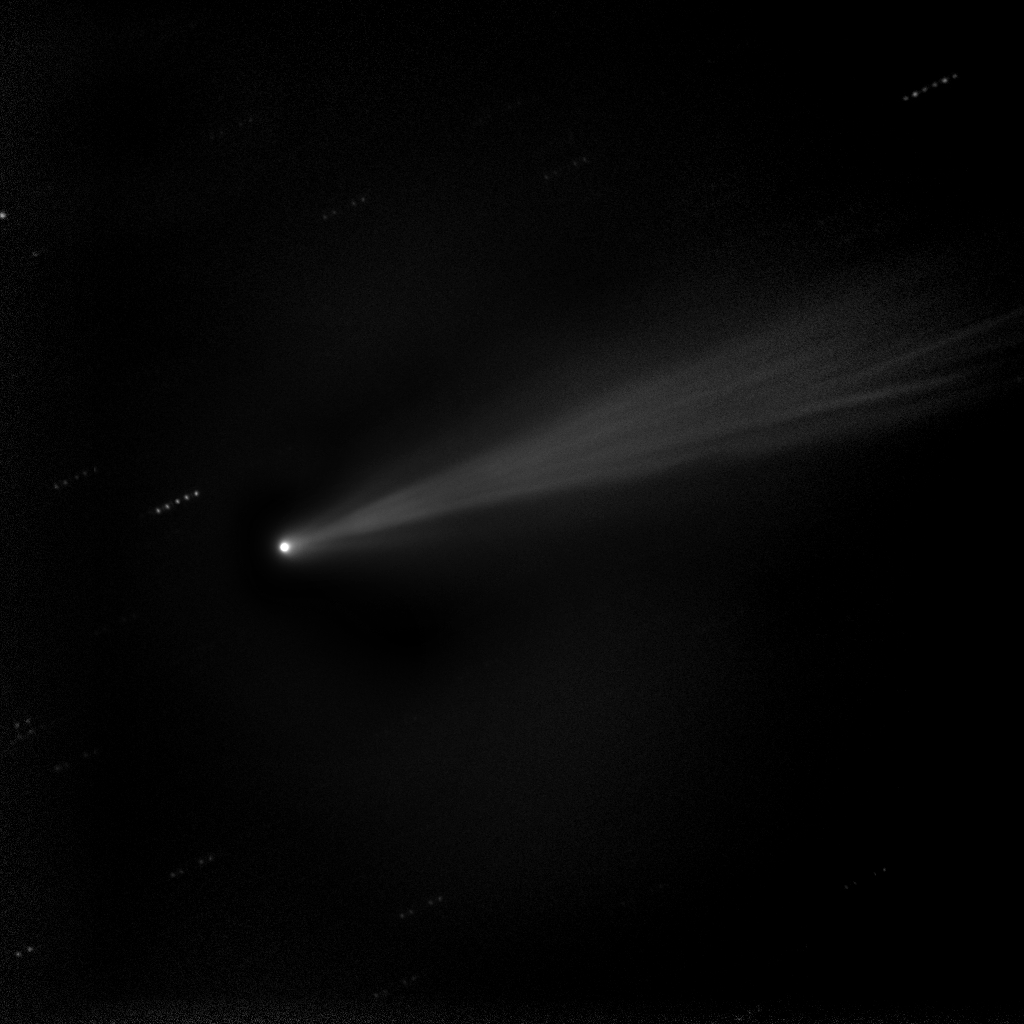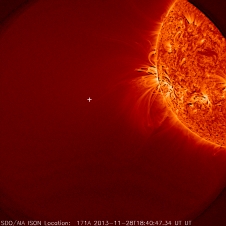 Image credit: NASA/MSFC/MEO/Cameron McCarty
Image credit: NASA/MSFC/MEO/Cameron McCarty
Taken on Nov. 19, 2013, this image shows a composite "stacked" image of comet ISON. These five stacked images of 10 seconds each were taken with the 20" Marshall Space Flight Center telescope in New Mexico. This technique allows the comet's sweeping tail to emerge with more detail.
Comet ISON was expected to put on a great show in Earth's sky in late 2013. Shortly after rounding the sun's far side on Nov. 28 (U.S. Thanksgiving), the comet faded, torn apart by the star's immense gravity.
"The comet's story begins with the very formation of the solar system," said Karl Battams, an astrophysicist at the Naval Research Lab in Washington, D.C. "The dirty snowball that we came to call Comet ISON was created at the same time as the planets."
ISON circled the solar system in the Oort cloud, more than 4.5 trillion miles away from the sun. At some point a few million years ago, something occurred – perhaps the passage of a nearby star – to knock ISON out of its orbit and send it hurtling along a path for its first trip into the inner solar system.
The comet was first spotted 585 million miles away in September 2012 by two Russian astronomers: Vitali Nevski and Artyom Novichonok. The comet was named after the project that discovered it, the International Scientific Optical Network, or ISON, and given an official designation of C/2012 S1 (ISON). When comet scientists mapped out Comet ISON's orbit they learned that the comet would swing within 1.1 million miles of the sun's surface, making it what's known as a sungrazing comet, providing opportunities to study this pristine bit of the early solar system as it lost material while approaching the higher temperatures of the sun. With this knowledge, an international campaign to observe the comet was born. The number of space-based, ground-based, and amateur observations was unprecedented, including 12 NASA space-based assets observing Comet ISON over the past year.
Near the beginning of October, 2013, two months before perihelion, NASA's Mars Reconnaissance Observer, or MRO, turned its HiRISE instrument to view the comet during its closest approach to Mars in October 2013.
"The size of ISON's nucleus could be a little over half a mile across --- at the most. Very likely it could have been as small as several hundred yards," said Alfred McEwen, the principal investigator for the HiRISE instrument at Arizona State University, in Tucson.
In other words, Comet ISON might have been the length of five or six football fields. This small size was near the borderline of how big ISON needed to be to survive its trip around the sun.
During that trip around the sun, Geraint Jones, a comet scientist at University College London's Mullard Space Science Laboratory in the UK studied the comet's dust tails to better understand what happened as it rounded the sun. By fitting models of the dust tail to the actual observations from NASA's Solar Terrestrial Observatory, or STEREO, and the joint European Space Agency/NASA Solar and Heliospheric Observatory, or SOHO, Jones showed that very little dust was produced after perihelion, which may suggest that the comet's nucleus had already broken up by that time.
While the comet was visible in STEREO and SOHO images going into perihelion, it was not visible in the data from NASA's Solar Dynamics Observatory, or SDO, or from ground based solar observatories during its closest approach to the sun. Dean Pesnell, project scientist for SDO at NASA's Goddard Space Flight Center in Greenbelt, Md., explained why Comet ISON wasn't visible in SDO and what could be learned from that: SDO is tuned to see wavelengths of light that would indicate the presence of oxygen, which is very common in comets.
"The fact that ISON did not show oxygen despite how close it came to the sun provides information about how high was the evaporation temperature of ISON's material," said Pesnell. "This limits what it could have been made of."
When Comet ISON was first spotted in September 2012, it was relatively bright for a comet at such a great distance from the sun. Consequently, many people had high hopes it would provide a beautiful light show visible in the night sky throughout December 2013. That potential ended when Comet ISON disrupted during perihelion. However, the legacy of the comet will go on for years as scientists analyze the tremendous data set collected during ISON's journey.
